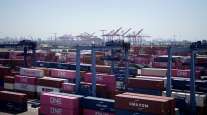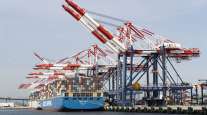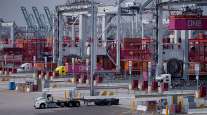Bloomberg News
Imports to Port of L.A. Drop, Hinting at Weaker Demand

[Stay on top of transportation news: Get TTNews in your inbox.]
The number of containers arriving at the Port of Los Angeles dropped by the most since the early days of the COVID-19 pandemic last month, an early indication that consumer demand could be starting to moderate.
Inbound loaded containers to the nation’s largest port fell 17% — the largest decline since May 2020 — to about 404,000 units in August from the previous month, the port said Sept. 15. The number of imported containers was the smallest handled so far this year, it said.
Despite the declines and a projection for lighter numbers in September, Executive Director Gene Seroka said he expects 2022 to be the complex’s second-busiest year on record.
During this morning’s cargo news briefing, Port of Los Angeles Executive Director Gene Seroka offered comments on the tentative rail agreement reached earlier today.
Watch the full video here: https://t.co/hifbzNmWNK pic.twitter.com/jb86OcYkkV — Port of Los Angeles (@PortofLA) September 15, 2022
Meanwhile, the neighboring port of Long Beach handled 5.6% fewer inbound containers last month compared with a year earlier, data showed Sept. 15. Imports have now fallen for two straight months at the operation. Despite the cooldown, last month was still the port’s second-busiest August on record.
The twin hubs of Los Angeles and Long Beach comprise the largest port complex in the U.S., handling about 40% of containerized trade with Asia.
The most recent data shows consumer spending and retail sales rising at a sluggish pace, a sign that the hottest inflation in almost four decades is starting to take its toll on the economy. Ports had for months been overwhelmed by an influx of goods that triggered supply chain logjams and delivery delays, but that is showing signs of abating due to logistics improvements and as interest rate increases are starting to cool demand.
Want more news? Listen to today's daily briefing above or go here for more info
“We still see this dichotomy between inflationary pressures, two consecutive quarters of economic decline, and all of us as American consumers buying more,” Seroka said in a virtual briefing Sept. 15. “We’ll continue to watch these and other indicators, but also level-set expectations around what the American consumer will do in the face of this generational inflation,” he said.
At the same time, Seroka added part of the decline has to do with the cargo diversion to other parts of the country as retailers rewire their shipping routes to avoid a repeat of last year’s supply chain snarls, and to avoid dealing with uncertainty around West Coast dockworker labor talks that still haven’t been finalized.
“I’m super-competitive — I don’t want to lose a pound of freight to any other port,” Seroka said. “But typically this happens, especially during contract negotiations, when some folks like to hedge.”




